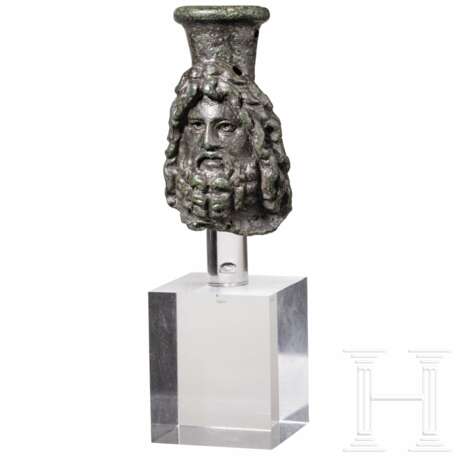ID 1323305
Lot 4094 | Bronzekopf des Serapis, römisch, 1. - 2. Jhdt. n. Chr.
Fein modellierter Kopf des Serapis mit präzise ausgeführten und wohlproportionierten anatomischen Details, die der Plastik eine eindrucksvolle Lebendigkeit verleihen: markante Augenbögen, darunter die tiefer liegenden Augenhöhlen mit Lidern und durch Bohrungen markierte Pupillen, die wohl einst in Silber eingelegt waren, ein Oberlippenbart über der fein ausgearbeiteten Unterlippe. Das lange Haupthaar sowie der Bart an Wangen und Kinn mit üppiger Lockenpracht gestaltet. Auf dem Kopf der typische Kalathos (Erntekorb). Die Frisur durch eine Binde gehalten. Hohlguss. Fragment einer Statue, modern auf Plexiglassockel montiert. Zwei kleine Gussfehler auf dem Kalathos, sonst ausgezeichnet erhaltene Kleinskulptur hoher Qualität mit einer schönen dunkelgrünen Patina.
Höhe ohne Sockel 4,5 cm. Mit Sockel 8,6 cm.
Provenienz: Kölner Privatsammlung, erworben 2010 in der Galerie am Museum Freiburg. Mit umfangreicher Dokumentation (Ankauf und Expertise).
A Roman bronze head of Serapis, 1st - 2nd century A.D.
A Roman bronze head of Serapis, 1st - 2nd century A.D.
Fein modellierter Kopf des Serapis mit präzise ausgeführten und wohlproportionierten anatomischen Details, die der Plastik eine eindrucksvolle Lebendigkeit verleihen: markante Augenbögen, darunter die tiefer liegenden Augenhöhlen mit Lidern und durch Bohrungen markierte Pupillen, die wohl einst in Silber eingelegt waren, ein Oberlippenbart über der fein ausgearbeiteten Unterlippe. Das lange Haupthaar sowie der Bart an Wangen und Kinn mit üppiger Lockenpracht gestaltet. Auf dem Kopf der typische Kalathos (Erntekorb). Die Frisur durch eine Binde gehalten. Hohlguss. Fragment einer Statue, modern auf Plexiglassockel montiert. Zwei kleine Gussfehler auf dem Kalathos, sonst ausgezeichnet erhaltene Kleinskulptur hoher Qualität mit einer schönen dunkelgrünen Patina.
Höhe ohne Sockel 4,5 cm. Mit Sockel 8,6 cm.
Provenance: Kölner Privatsammlung, erworben 2010 in der Galerie am Museum Freiburg. Mit umfangreicher Dokumentation (Ankauf und Expertise).
Condition: I
| Place of origin: | Roman Empire |
|---|
| Place of origin: | Roman Empire |
|---|
| Address of auction |
Hermann Historica Bretonischer Ring 3 85630 Grasbrunn / München Germany | ||||||||||||||
|---|---|---|---|---|---|---|---|---|---|---|---|---|---|---|---|
| Preview | |||||||||||||||
| Phone | +49 (0)89 5472 649 0 | ||||||||||||||
| Fax | +49 (0)89 5472 64999 | ||||||||||||||
| Buyer Premium | 25 % | ||||||||||||||
| Conditions of purchase | Conditions of purchase | ||||||||||||||
| Business hours | Business hours
|



